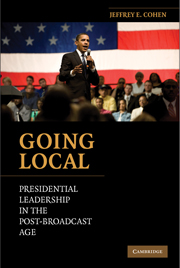Book contents
- Frontmatter
- Contents
- List of Figures
- List of Tables
- Introduction
- 1 Context and Presidential Leadership Styles
- 2 Increasing Presidential Attention to Narrow Groups
- 3 Presidents and the Local News Media
- 4 A Theory of Presidential News Management and Local News Coverage
- 5 The Quantity of Local Newspaper Coverage of the President
- 6 Trends in Local Newspaper Coverage of the Presidency, 1990–2007
- 7 On the Tone of Local Presidential News
- 8 Local Presidential News Coverage and Public Attitudes toward the President
- 9 Conclusions: Presidential Leadership in the Post-Broadcast Age
- Bibliography
- Index
3 - Presidents and the Local News Media
Published online by Cambridge University Press: 05 June 2012
- Frontmatter
- Contents
- List of Figures
- List of Tables
- Introduction
- 1 Context and Presidential Leadership Styles
- 2 Increasing Presidential Attention to Narrow Groups
- 3 Presidents and the Local News Media
- 4 A Theory of Presidential News Management and Local News Coverage
- 5 The Quantity of Local Newspaper Coverage of the President
- 6 Trends in Local Newspaper Coverage of the Presidency, 1990–2007
- 7 On the Tone of Local Presidential News
- 8 Local Presidential News Coverage and Public Attitudes toward the President
- 9 Conclusions: Presidential Leadership in the Post-Broadcast Age
- Bibliography
- Index
Summary
In response to the rise of polarized parties and a fragmented media, presidents have altered their going public leadership style. Rather than build national public support, presidents in the post-broadcast age pursue a narrower going public style that focuses on their party base, certain interest groups, and select localities. The previous chapter reviewed evidence that presidents engage these narrow groups more in the present age than they did previously. This chapter looks more closely at presidential engagement with localities. As argued earlier, presidents have primarily two means of building public support in localities, by visiting them or through news coverage.
Local visits are costly to presidents, and they can visit only one locality at a time. Presidential activities aimed at the local news media may provide a more cost-effective approach to building local support. Localities present presidents with several news media, local television and local newspapers being the most important. How important are these two local news media to presidential going public efforts? This chapter presents evidence that, despite declining readerships in the late 1990s and early 2000s, local newspapers may be more important to presidents than local television.
Three characteristics of local newspapers make them potentially important to presidents: 1) their comparatively large audience, 2) their relatively high credibility, especially compared with other news sources, and 3) the significant amount of news on the presidency that they report to their readers.
- Type
- Chapter
- Information
- Going LocalPresidential Leadership in the Post-Broadcast Age, pp. 54 - 70Publisher: Cambridge University PressPrint publication year: 2009

